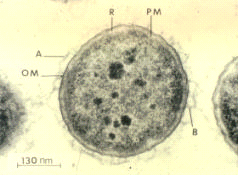Photobacterium damselaesubsp.piscicida is a gram-negative rod-shaped bacterium that causes disease in fish.
Mycobacterium gastri is a species of the phylum Actinomycetota, belonging to the genus Mycobacterium.
Mycobacterium heidelbergense is a Gram-positive, nonmotile, acid-fast coccobacillus. It is a species of the phylum Actinomycetota, belonging to the genus Mycobacterium.
Mycobacterium hodleri is a species of the phylum Actinomycetota, belonging to the genus Mycobacterium.
Mycobacterium intermedium is a species of the phylum Actinomycetota, belonging to the genus Mycobacterium.
Enterococcus gallinarum is a species of Enterococcus. E. gallinarum demonstrates an inherent, low-level resistance to vancomycin. Resistance is due to a chromosomal gene, vanC, which encodes for a terminal D-alanine-D-serine instead of the usual D-alanine-D-alanine in cell wall peptidoglycan precursor proteins. That is a separate mechanism than the vancomycin resistance seen in VRE isolates of E. faecium and E. faecalis which is mediated by vanA or vanB. This species is known to cause clusters of infection, although it considered very rare. It is the only other known enterococcal species besides E. faecium and E. faecalis known to cause outbreaks and spread in hospitals.

Aeromonas salmonicida is a pathogenic bacterium that severely impacts salmonid populations and other species. It was first discovered in a Bavarian brown trout hatchery by Emmerich and Weibel in 1894. Aeromonas salmonicida's ability to infect a variety of hosts, multiply, and adapt, make it a prime virulent bacterium. A. salmonicida is an etiological agent for furunculosis, a disease that causes sepsis, haemorrhages, muscle lesions, inflammation of the lower intestine, spleen enlargement, and death in freshwater fish populations. It is found worldwide with the exception of South America. The major route of contamination is poor water quality; however, it can also be associated stress factors such as overcrowding, high temperatures, and trauma. Spawning and smolting fish are prime victims of furunculosis due to their immunocompromised state of being.
Pediococcus damnosus is a species of Gram-positive bacteria. The genus Pediococcus is a spherical cocci shaped bacteria with nonmotile, non spore-forming and homofermentative properties. P. damnosus is a chemo-organotrophic, catalase negative, facultative anaerobe. Strains of this species frequently grow in wine and beer, where they overproduce glucan and spoil products by increasing their viscosity. P. damnosus is a lactic acid bacteria (LAB), that can tolerate the low pH and higher ethanol levels that are found in beer. The ability to grow in beer is a strain specific characteristic of the species P. damnosus. Pediococcus damnosus LMG 28219 is a lactic acid bacterium that has proved to be capable of growing in beer.
Bordetella trematum is a species of Gram-negative bacteria identified in 1996 by comparison of 10 strains of B. trematum against other well characterized Bordetella and Alcaligenes species. The term trema refers to something pierced or penetrated, or to a gap. "Trematum" pertains to open things, and refers to the presence of bacteria in wounds and other exposed parts of the body. Strain LMG 13506T is the reference strain for this species.
Limosilactobacillus pontis is a rod-shaped, Gram-positive facultatively anaerobic bacterium. Along with other Lactobacillus species, it is capable of converting sugars, such as lactose, into lactic acid. Limosilactobacillus pontis is classified under the phylum Bacillota, class Bacilli, and is a member of the family Lactobacillaceae and is found to be responsible for the fermentation of sourdough, along with many other Lactobacillus species. This microorganism produces lactic acid during the process of fermentation, which gives sourdough bread its characteristic sour taste.
Luteimonas aquatica is a species of yellow-pigmented bacteria. It is Gram-negative, rod-shaped and non-spore-forming, with type strain RIB1-20(T).
Phyllobacterium trifolii is a root-nodulating bacteria that was first isolated from nodules in Trifolium and Lupinus species. Its type strain is PETP02T.
Enterococcus raffinosus is a bacterial species of the Gram-positive genus Enterococcus, named for its facultative anaerobic metabolism, including the ability to ferment the trisaccharide raffinose. This mesophilic microaerophile has optimal growth at 37°C in Columbia Blood Medium. It has an ovoid morphology categorized as coccal with arrangement singly, in pairs, or short chains.
Enterococcus haemoperoxidus is a species of Enterococcus with type strain CCM 4851T.
Enterococcus moraviensis is a species of Enterococcus with type strain CCM 4856T.
Meiothermus timidus is a species of yellow-pigmented Deinococcota bacteria. It was first isolated from the hot spring at São Pedro do Sul, in central Portugal, and at the island of Sao Miguel in the Azores. Its type strain is SPS-243T. The species was differentiated with the 16S rRNA gene sequence and biochemical characteristics.
Rhizobium lentis is a gram-negative bacterium which was isolated from root nodules of lentils in Bangladesh.
Vibrio aerogenes is a gram-negative organism that is rod-shaped and has a two-sheathed flagella that is found on one side of the cell that makes it motile. When it is grown on polypeptone-yeast (PY) plate medium, the colonies are usually round and flat. It is an organism that is mesophilic which means it likes temperatures that are between 20-45°C. In addition, it is facultatively anaerobic, which means it can survive with or without oxygen. This is a marine bacteria that is most commonly found in temperatures between 30°C and 35°C and pH 6-7. It requires Na+ to grow and this is what makes the marine environment a necessity for this organism. V. aerogenes can ferment glucose and a few other carbohydrates to yield organic acids.
Cavicella is a genus of bacteria which belongs to the class Gammaproteobacteria with one known species. Cavicella subterranea has been isolated from mineral water from a 150-metre-deep borehole in Portugal.

Ensifer numidicus is a nitrogen fixing symbiont of Fabaceae. gram-negative, aerobic, non-spore forming, rod-shaped bacterium of the family Rhizobiaceae. First described in 2010; more biovars have since been isolated and described with ORS 1407 considered the representative organism. Most examples have been found in arid and infra-arid regions of Tunisia.

